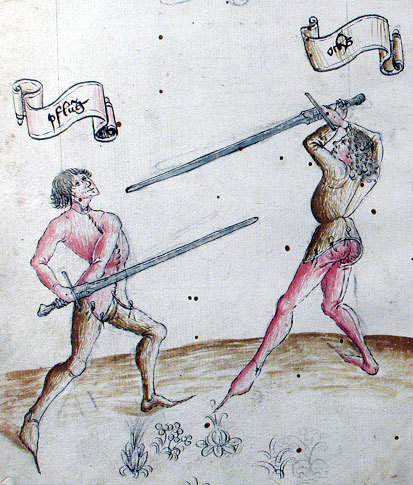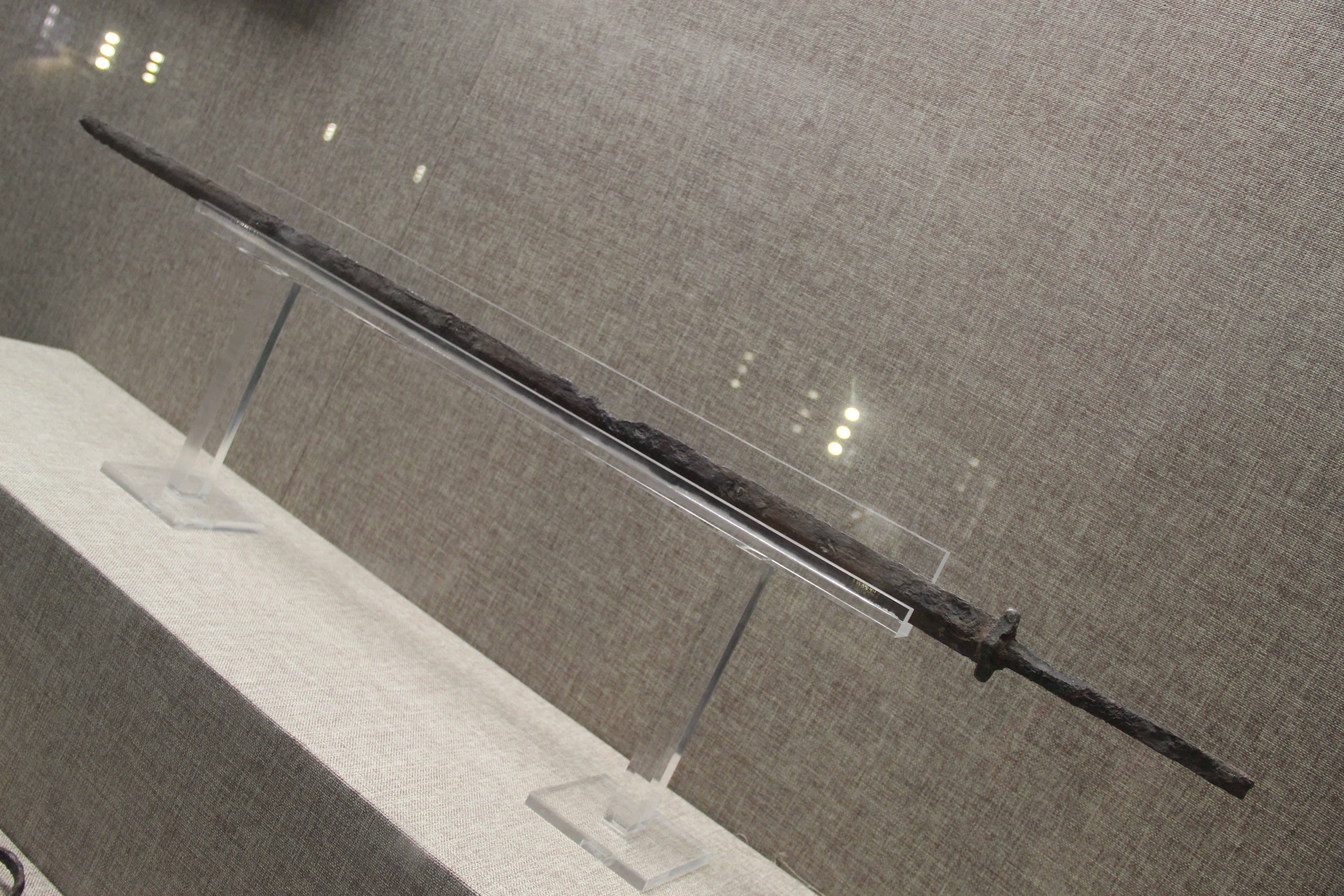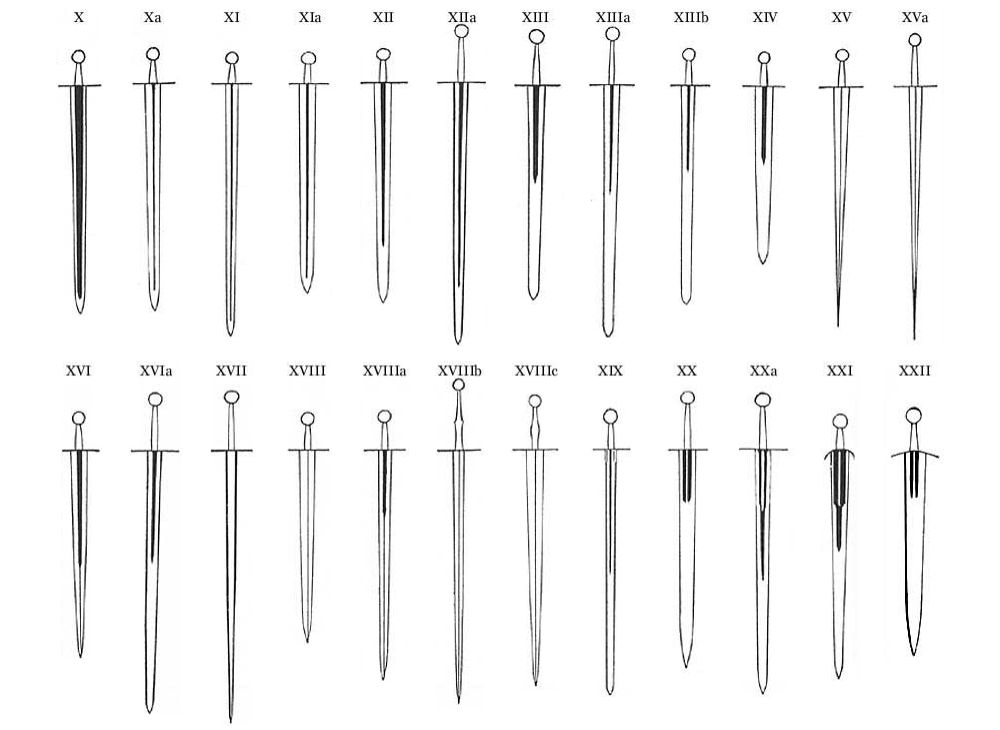|
Longsword
A longsword (also spelled as long sword or long-sword) is a type of European sword characterized as having a cruciform hilt with a grip for primarily two-handed use (around ), a straight double-edged blade of around , and weighing approximately . The "longsword" type exists in a morphological continuum with the medieval knightly sword and the Renaissance-era Zweihänder. It was prevalent during the late medieval and Renaissance periods (approximately 1350 to 1550), with early and late use reaching into the 12th and 17th centuries. Names English The longsword has many names in the English language, which, aside from variant spellings, include terms such as "bastard sword" and "hand-and-a-half sword." Of these, "bastard sword" is the oldest, its use being contemporaneous with the weapon's heyday. The French ' and the English "bastard sword" originate in the 15th or 16th century, originally in the general sense of "irregular sword, sword of uncertain origin", but by the ... [...More Info...] [...Related Items...] OR: [Wikipedia] [Google] [Baidu] |
German School Of Fencing
The German school of fencing (') is a system of combat taught in the Holy Roman Empire during the Late Medieval, German Renaissance, and Early Modern periods. It is described in the contemporary Fechtbücher ("fencing books") written at the time. The geographical center of this tradition was in what is now Southern Germany including Augsburg, Frankfurt, and Nuremberg. During the period in which it was taught, it was known as the ', or the ''"Art of Fighting"''. The German school of fencing focuses primarily on the use of the two-handed longsword; it also describes the use of many other weapons, including polearms, medieval daggers, messers (with or without a buckler), and the staff, as well as describing mounted combat and unarmed grappling ('' ringen''). Most authors of writings on the system are, or claim to be, in the tradition of the 14th-century master Johannes Liechtenauer. The earliest surviving treatise on Liechtenauer's system is a manuscript dated to 1389, known ... [...More Info...] [...Related Items...] OR: [Wikipedia] [Google] [Baidu] |
Sword
A sword is an edged, bladed weapon intended for manual cutting or thrusting. Its blade, longer than a knife or dagger, is attached to a hilt and can be straight or curved. A thrusting sword tends to have a straighter blade with a pointed tip. A slashing sword is more likely to be curved and to have a sharpened cutting edge on one or both sides of the blade. Many swords are designed for both thrusting and slashing. The precise definition of a sword varies by historical epoch and geographic region. Historically, the sword developed in the Bronze Age, evolving from the dagger; the earliest specimens date to about 1600 BC. The later Iron Age sword remained fairly short and without a crossguard. The spatha, as it developed in the Late Roman army, became the predecessor of the European sword of the Middle Ages, at first adopted as the Migration Period sword, and only in the High Middle Ages, developed into the classical arming sword with crossguard. The word '' sword'' conti ... [...More Info...] [...Related Items...] OR: [Wikipedia] [Google] [Baidu] |
Sword
A sword is an edged, bladed weapon intended for manual cutting or thrusting. Its blade, longer than a knife or dagger, is attached to a hilt and can be straight or curved. A thrusting sword tends to have a straighter blade with a pointed tip. A slashing sword is more likely to be curved and to have a sharpened cutting edge on one or both sides of the blade. Many swords are designed for both thrusting and slashing. The precise definition of a sword varies by historical epoch and geographic region. Historically, the sword developed in the Bronze Age, evolving from the dagger; the earliest specimens date to about 1600 BC. The later Iron Age sword remained fairly short and without a crossguard. The spatha, as it developed in the Late Roman army, became the predecessor of the European sword of the Middle Ages, at first adopted as the Migration Period sword, and only in the High Middle Ages, developed into the classical arming sword with crossguard. The word '' sword'' conti ... [...More Info...] [...Related Items...] OR: [Wikipedia] [Google] [Baidu] |
Historical Martial Arts Reconstruction
Historical European martial arts (HEMA) are martial arts of European origin, particularly using arts formerly practised, but having since died out or evolved into very different forms. While there is limited surviving documentation of the martial arts of classical antiquity (such as Greek wrestling or gladiatorial combat), surviving dedicated technical treatises or martial arts manuals date to the Late Middle Ages and the early modern period. For this reason, the focus of HEMA is ''de facto'' on the period of the half-millennium of ca. 1300 to 1800, with a German and an Italian school flowering in the Late Middle Ages and the Renaissance (14th to 16th centuries), followed by Spanish, Portuguese, French, English, and Scottish schools of fencing in the modern period (17th and 18th centuries). Arts of the 19th century such as classical fencing, and even early hybrid styles such as Bartitsu, may also be included in the term HEMA in a wider sense, as may traditional or folkloristic ... [...More Info...] [...Related Items...] OR: [Wikipedia] [Google] [Baidu] |
Knightly Sword
In the European High Middle Ages, the typical sword (sometimes academically categorized as the knightly sword, arming sword, or in full, knightly arming sword) was a straight, double-edged weapon with a single-handed, cruciform (i.e., cross-shaped) hilt and a blade length of about . This type is frequently depicted in period artwork, and numerous examples have been preserved archaeologically. The high medieval sword of the Romanesque period (10th to 13th centuries) developed gradually from the Viking sword of the 9th century. In the Late Medieval period (14th and 15th centuries), late forms of these swords continued to be used, but often as a sidearm, at that point called "arming swords" and contrasting with the two-handed, heavier longswords. Though the majority of late-medieval arming swords kept their blade properties from previous centuries, there are also surviving specimens from the 15th century that took the form of a late-medieval estoc, specialised for use against mor ... [...More Info...] [...Related Items...] OR: [Wikipedia] [Google] [Baidu] |
Zweihänder
The ''Zweihänder'' () (German 'two-hander'), also ''Doppelhänder'' ('double-hander'), ''Beidhänder'' ('both-hander'), ''Bihänder'' or ''Bidenhänder'', is a large two-handed sword primarily in use during the 16th century. ''Zweihänder'' swords developed from the longswords of the Late Middle Ages and became the hallmark weapon of the German ''Landsknechte'' from the time of Maximilian I (d. 1519) and during the Italian Wars of 1494–1559. The '' Goliath Fechtbuch'' (1510) shows an intermediate form between longsword and ''Zweihänder''. These swords represent the final stage in the trend of increasing size that started in the 14th century. In its developed form, the ''Zweihänder'' acquired the characteristics of a polearm rather than a sword due to their large size and weight and therefore increased range and striking power. Consequently, it was not carried in a sheath but across the shoulder like a halberd. By the second half of the 16th century, these swords ha ... [...More Info...] [...Related Items...] OR: [Wikipedia] [Google] [Baidu] |
Rapier
A rapier () or is a type of sword with a slender and sharply-pointed two-edged blade that was popular in Western Europe, both for civilian use (dueling and self-defense) and as a military side arm, throughout the 16th and 17th centuries. Important sources for rapier fencing include the Italian Bolognese group, with early representatives such as Antonio Manciolino and Achille Marozzo publishing in the 1530s, and reaching the peak of its popularity with writers of the early 1600s ( Salvator Fabris, Ridolfo Capo Ferro). In Spain, rapier fencing came to be known under the term of ("dexterity") in the second half of the 16th century, based on the theories of Jerónimo Sánchez de Carranza in his work ("The Philosophy of Arms and of their Dexterity and of Aggression and the Christian Defence"), published in 1569. The best known treatise of this tradition was published in French, by Girard Thibault, in 1630. The French small sword or court sword of the 18th century was a dire ... [...More Info...] [...Related Items...] OR: [Wikipedia] [Google] [Baidu] |
Half-sword
Half-sword, in 14th- to 16th-century fencing with longswords, refers to the technique of gripping the central part of the sword blade with the left hand in order to execute more forceful thrusts against armoured and unarmoured opponents. The term is a translation of the original German ''Halbschwert''. The technique was also referred to as ''mit dem kurzen Schwert'', "with the shortened sword" in German. Half-sword is used for leverage advantage when wrestling with the sword, as well as for delivering a more accurate and powerful thrust. Both of these are critical when fighting in plate armour because a slice or a cleaving blow from a sword is virtually useless against iron or steel plate. Most medieval treatises show armoured combat as consisting primarily of fighting at the half-sword; the best options against an armoured man being a strong thrust into less-protected areas such as the armpits or throat or, even better, the same against a man who has already been cast to the gr ... [...More Info...] [...Related Items...] OR: [Wikipedia] [Google] [Baidu] |
Claymore
A claymore (; from gd, claidheamh- mòr, "great sword") is either the Scottish variant of the late medieval two-handed sword or the Scottish variant of the basket-hilted sword. The former is characterised as having a cross hilt of forward-sloping quillons with quatrefoil terminations and was in use from the 15th to 17th centuries. The weapon was also employed by the Irish and favoured by the mercenary Gallowglass in battle. The word ''claymore'' was first used in reference to basket-hilted swords during the 18th century in Scotland and parts of England. This description was maybe not used during the 17th century, when basket-hilted swords were the primary military swords across Europe, but these basket-hilted, broad-bladed, swords remained in service with officers of Scottish regiments into the 21st century. After the Acts of Union in 1707 when Scottish and English regiments were integrated together, the swords were seen as a mark of distinction by Scottish officers ove ... [...More Info...] [...Related Items...] OR: [Wikipedia] [Google] [Baidu] |
Oakeshott Type
The Oakeshott typology is a way to define and catalogue the medieval sword based on physical form. It categorises the swords of the European Middle Ages (roughly 11th to 16th centuries) into 13 main types, labelled X through XXII. The historian and illustrator Ewart Oakeshott introduced it in his 1960 treatise ''The Archaeology of Weapons: Arms and Armour from Prehistory to the Age of Chivalry''. The system is a continuation of Jan Petersen's typology of the Viking sword, which Petersen introduced in ''De Norske Vikingsverd'' ("The Norwegian Viking Swords") in 1919. In 1927 the system was simplified by R. E. M. Wheeler to only seven types, labelled I through VII. Oakeshott slightly expanded the system with two transitional types, VIII and IX, and then he started work on his own typology. Among the many reasons for his typology, Oakeshott found date classification unreliable during his research. He wrote that the weapons' dates of manufacture, use, and retirement have been greatl ... [...More Info...] [...Related Items...] OR: [Wikipedia] [Google] [Baidu] |
Duel
A duel is an arranged engagement in combat between two people, with matched weapons, in accordance with agreed-upon rules. During the 17th and 18th centuries (and earlier), duels were mostly single combats fought with swords (the rapier and later the small sword), but beginning in the late 18th century in England, duels were more commonly fought using pistols. Fencing and shooting continued to co-exist throughout the 19th century. The duel was based on a code of honor. Duels were fought not so much to kill the opponent as to gain "satisfaction", that is, to restore one's honor by demonstrating a willingness to risk one's life for it, and as such the tradition of dueling was originally reserved for the male members of nobility; however, in the modern era, it extended to those of the upper classes generally. On occasion, duels with swords or pistols were fought between women. Legislation against dueling goes back to the medieval period. The Fourth Council of the Lateran (1 ... [...More Info...] [...Related Items...] OR: [Wikipedia] [Google] [Baidu] |
Scottish Gaelic Language
Scottish Gaelic ( gd, Gàidhlig ), also known as Scots Gaelic and Gaelic, is a Goidelic language (in the Celtic branch of the Indo-European language family) native to the Gaels of Scotland. As a Goidelic language, Scottish Gaelic, as well as both Irish and Manx, developed out of Old Irish. It became a distinct spoken language sometime in the 13th century in the Middle Irish period, although a common literary language was shared by the Gaels of both Ireland and Scotland until well into the 17th century. Most of modern Scotland was once Gaelic-speaking, as evidenced especially by Gaelic-language place names. In the 2011 census of Scotland, 57,375 people (1.1% of the Scottish population aged over 3 years old) reported being able to speak Gaelic, 1,275 fewer than in 2001. The highest percentages of Gaelic speakers were in the Outer Hebrides. Nevertheless, there is a language revival, and the number of speakers of the language under age 20 did not decrease between the 2001 a ... [...More Info...] [...Related Items...] OR: [Wikipedia] [Google] [Baidu] |



_1r.jpg)


.jpg)


